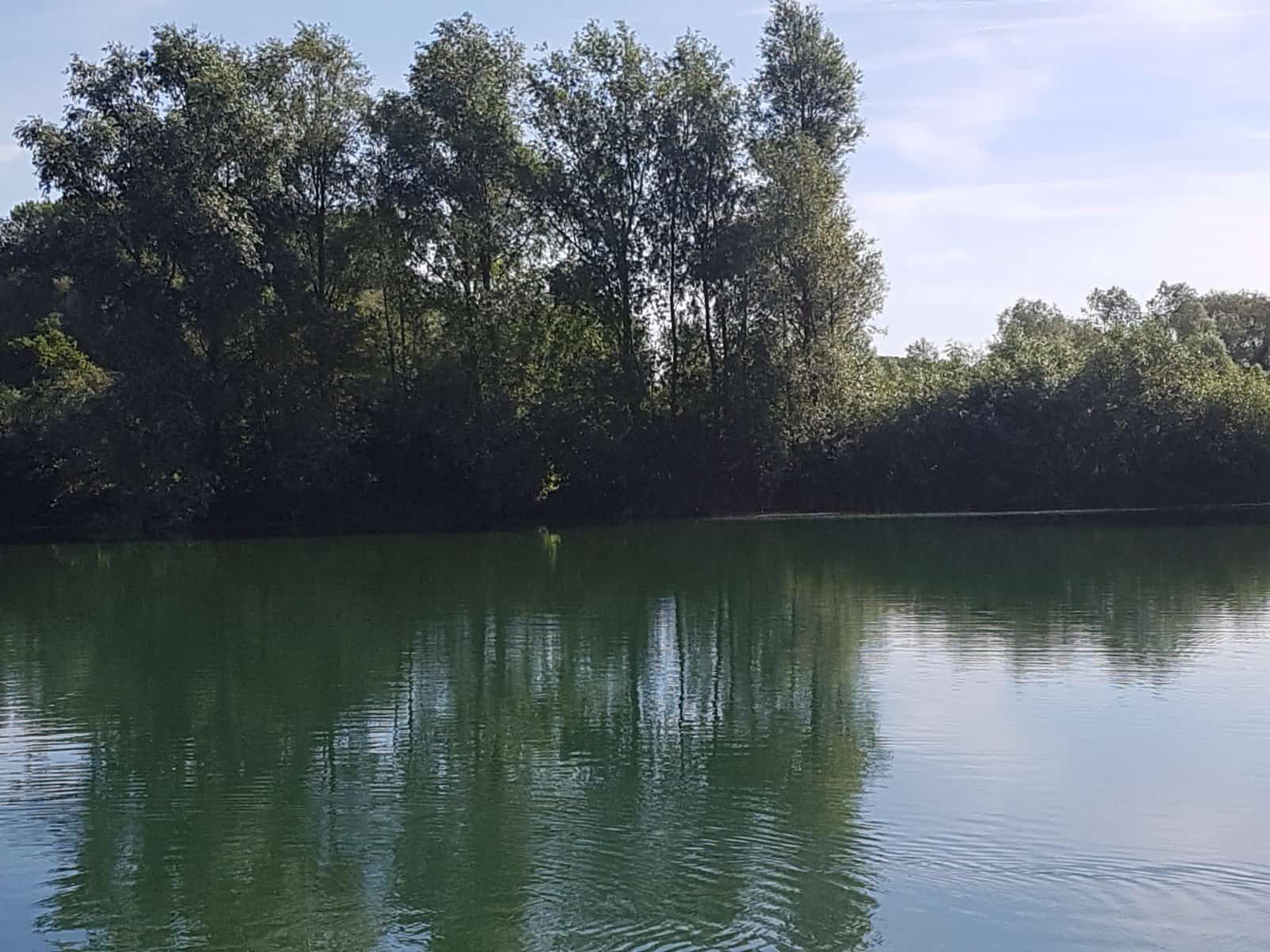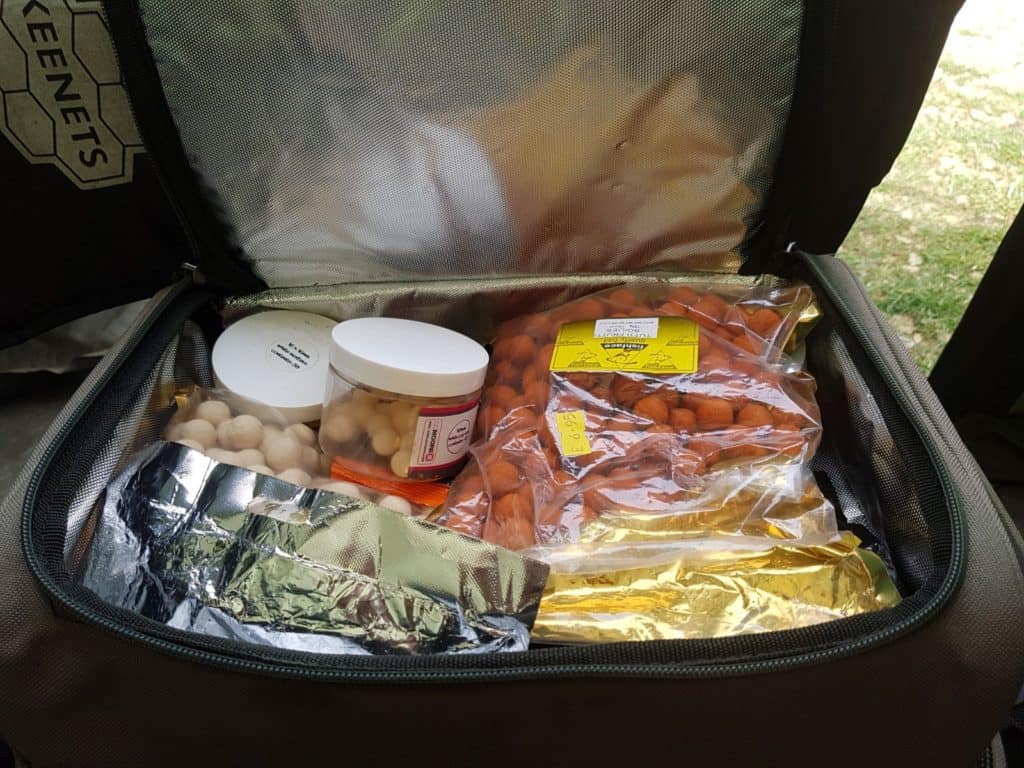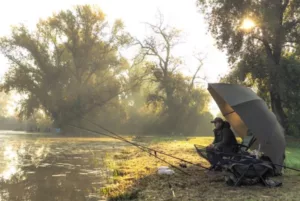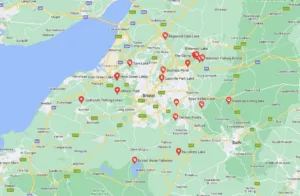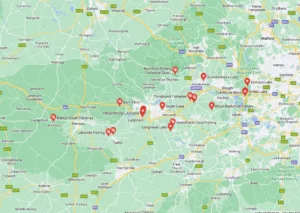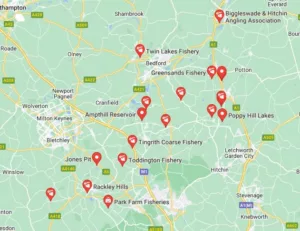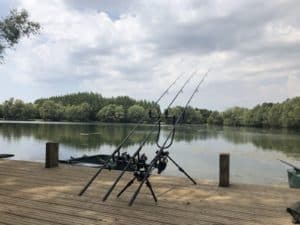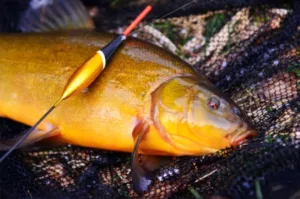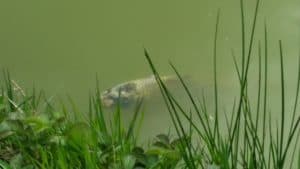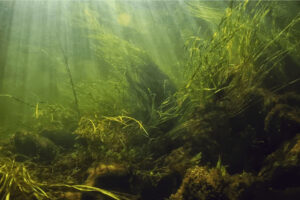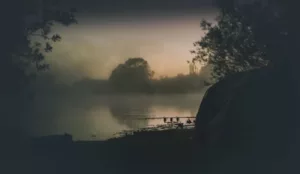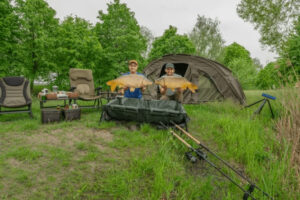Where to find carp in a lake is very much dependant on quite a few variables. If you are fishing a runs water, the fish are likely going to be anywhere and everywhere in the lake.
This is typically due to the volume of fish in the lake compared to the size of the lake.
You probably won’t have too much trouble trying to find them relatively quickly.
If the lake has only a few occupants, it’s likely you will need to hunt them down using your watercraft skills and lots of patience.
We need to break this down into a few scenarios and situations and discuss the typical holding spots for carp in each scenario.
Heavily Stocked Lakes
With heavily stocked lakes, which hold lots of single figure carp, you will normally find that they are very energetic and almost suicidal, so it shouldn’t be hard to find a few fish swimming around to target.
Trickling a handful of bait every now and then will draw the carp in if you cant find them, but try and feed a particular spot such as the margin so you can bait up accurately. Little and often is the normal advice.
Look for fish jumping and bubbles appearing, but fishing tight to islands usually produce fish pretty quickly.
Every time I turn up at a lake, I always have a walk around with a pair of sunglasses with polarized lenses (these are the glasses I use) and watch out for swirls and bubbles in the lake.
A lot of anglers I know don’t do this and its one of their biggest mistakes.
You could spend your whole session in the wrong swim when the fish are all basking in the sun at the other end of the lake.
Make sure you have a good walk around first before settling on a swim, especially if you are fishing a long session.
Surface Fishing With Floating Baits
If the sun is out and the temperature is warm, you will likely find the fish in the top layers of the water.
Typically in the first two feet of water, so fishing with zig rigs or floating baits would be my advice.
Although remember to take plenty of bread to feed off the birds if you are using floating baits, else you will run out of floating baits very quickly.
I use the Korda surface controller float when catching fish in the upper layers, similar to this one as it gives me ultimate control.
Its streamlined design and allows me to cast further into the lake than other surface controllers due to the weight.
This ensures I can get to the fish wherever I see them in the lake as it flies through the air like a rocket.
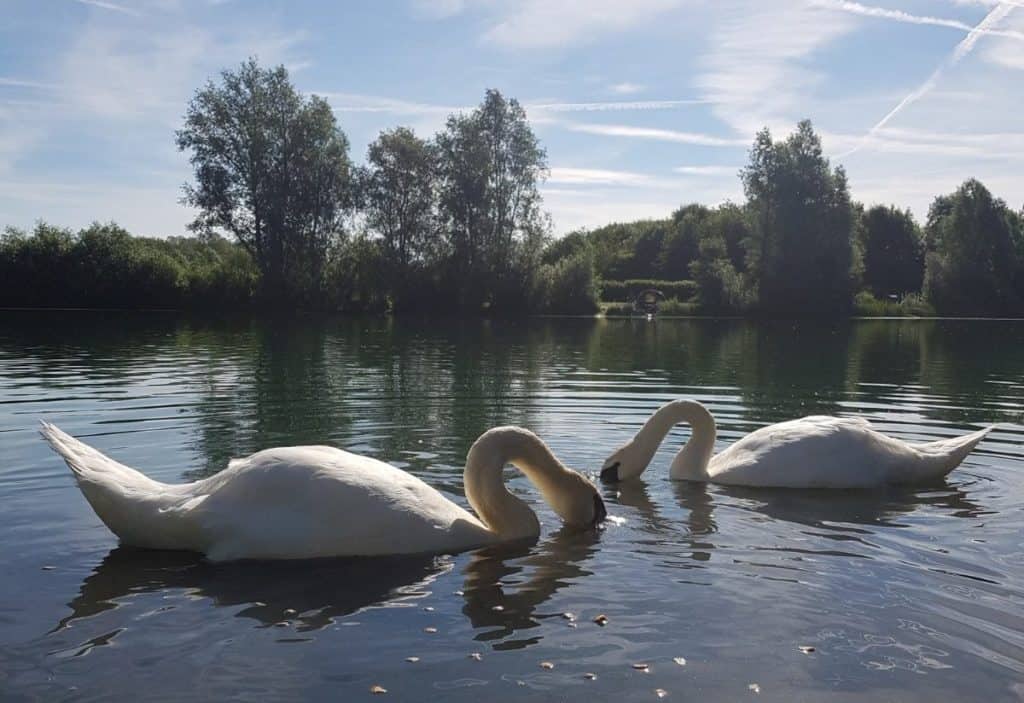
These dear birds scuppered my chances of a fish off the top by continuing to eat every dog biscuit I had in my bag
Zig Rig Fishing
When using zig rigs, find out the depth of where you can see the fish using a marker float or a DEEPER Sonar.
I am very capable of tying zig rigs, but these ready-made zig rigs have made my life a lot simpler when zig rig fishing.
Start your zig rig fishing one-foot below the surface of the water and if you don’t get any bites, adjust your rig one-foot deeper in the water every 15 minutes. Nash sells a zig rig float that makes your zig rig fully adjustable, which is amazing and saves tons of messing about. You can find them here if you haven’t already got one.
With the adjustable zig rig float, gone are the days of having to wind the rig in, shorten it and re-tie the rig. With the adjustable float, you simply wind the reel in one-foot each time to find the fish very quickly, saving the worries of the rig tangling on the recast.
Also, with the adjustable zig rig float, you do not need to use the marker float to find the depth. Because of the adjustable floats mechanics, you can cast the float into the lake at any depth. Then, use it just as a marker float by paying the line out until you see the bait pop up out of the water. Once you see the bait, wind the reel in slowly until the bait disappears, then wind the reel in one-foot at a time until you are at the depth you want to be fishing at.
If you are certain the fish are in the top layers on the water, try two or three rods on zig rigs, but have a different color bait on each rod. If you get a bite, change your other baits on the other rods to match the color of bait that got the bite.
Fishing Tight Against Islands
Carp are renowned for feeding around islands and using the islands for cover.
The beauty of fishing to the islands is that you can bait up a couple of spots and it’s likely the fish will patrol along the islands and find at least one of your rigs.
You can send out a wide spread of bait to draw the fish into your rig, or send out tight PVA bags (I have a full PVA guide here) with small parcels or bait to pick off fish. With the island to cast to, you can use it as a reference for distance, which is a lot easier than casting into a huge expanse of water and trying to gauge whether you are fishing to the right spot, consistently.
Over-hanging trees on islands are also a good area to fish to, as the fish use the trees for protection which will make them feel safer. When you cast out, try and get the cast as tight to the over-hanging branches as possible, but make sure you judge the cast careful or you will find your rig in the trees!
Lily Pads and Reed Beds
If there are lily pads or reed beds in the lake you are fishing, look carefully, you will likely see the fish swimming or just basking amongst them. You will typically see the lily pads or reeds moving as the fish are swimming through them.
You won’t be able to get a rig into the lily pads or reeds unless you are using a float, well strictly that’s not true (I’ve seen a guy casting method balls into the rushes before), but if you do hook a fish, you will more than likely struggle to get them out without pulling the hook.
Low Stocked Lakes
In lower stock lakes, you may find fish hiding as stated above, but the chances are, you will need to look a bit harder for them.
It’s likely that the more weary fish who have a few years and a bit of experience behind them will likely be hiding under overhanging trees and very hard to reach spots in the lake.
I learned a very valuable lesson when starting out about where the big fish go to hide, as I explained in this blog post.
When it comes to the wiser fish, they will literally pick at small bits of bait rather than piles of bait. Mainly because they have been caught many times before when feeding on big piles of food.
Many anglers have sat fishing a lake for years before they learn the habits of the fish in the lake and where they go to feed.
Some anglers have blanked for years at a time on certain lakes before catching any fish.
If you want a huge advantage over other anglers when it comes to low stock lakes with large wise carp, it really is a case of learning the patterns of the lake by putting the time in on the bank.
Each time you are there, you should be making notes as to where you see the fish show, any jumpers? bubbles? But also, spending time talking to other anglers fishing that particular lake.
That’s how I found out about Dave’s major success on Winton’s fishery in Sussex, catching 38 out of the 44 thirty-plus lb carp in less than a year. If I didn’t put time into the lake and help other anglers when they needed help, I wouldn’t have learned his little secrets, nor the methodology behind the rigs.
Don’t Ignore The Margins
I had been fishing a large complex not far from my house, but not having much luck.
The lake was completely flat, so not many features to fish to. There was a channel at the back of the lake and sometimes you could see the fish swirling in this area, which meant everyone wanted the channel swim and always rushed to be the first there.
I have started to lose interest in the lake and only stuck with it because I knew how big the fish were in front of me.
I had all of the toys out to figure out the lake, the marker float, the FishSpy… the lot! But after a year of fishing the lake on and off, things changed dramatically.
I was fishing the lake on my own one evening and had three rods spread around the lake. The left rod over by the rushes, the right rod deep into the channel and the middle rod being cast to any sign of movement.
All of a sudden, a huge fish jumped right in front of me. The fish jumped only one-rod length out from the front of my swim, I couldn’t figure out what was going on.
So I threw a handful of boilies out to where I saw the fish jump and put the middle rod on the spot.
Almost instantly, the rod tore off.
This happened over and over, and the secret of the lake was revealed! The fish were feeding off of the bait that the anglers threw into the lake once their sessions had finished.
Seems obvious when you think about it!
It completely changed the way I fished that lake from now on.
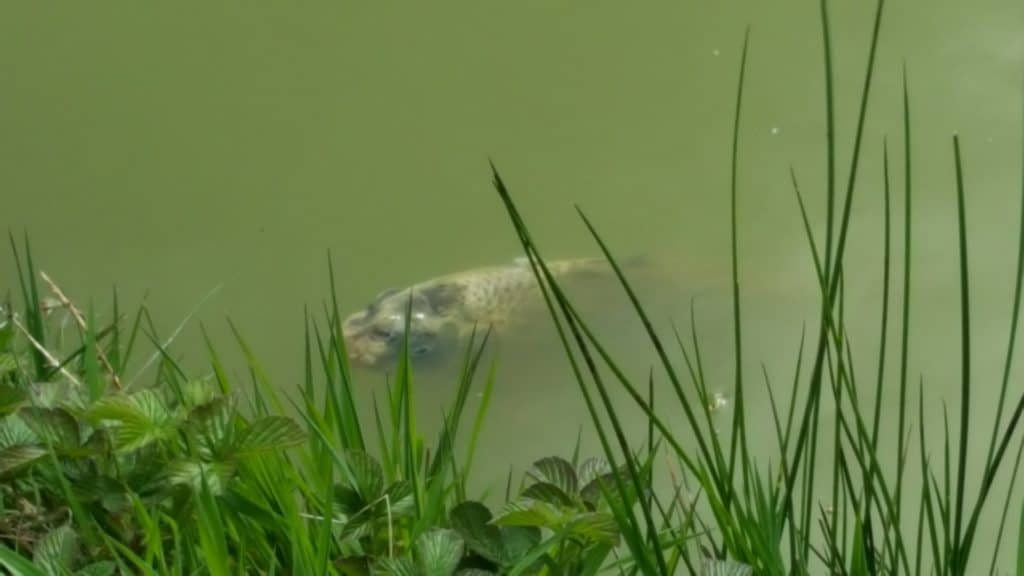
Don’t ignore the margins, the fish will feed off of the bait that anglers throw into the swim after their session
Signs of Carp Feeding
The typical signs of carp feeding in lakes with clay or silty bottoms are when the water seems a lot muddier than other parts of the lake. This is an obvious sign that fish have been digging through the dirt and looking for food.
Another sign is bubbles. Sometimes this is just the gases from the lake bed, but if the bubbles seem to be moving, then its likely that this is a fishing “chewing” on food and letting the air out of its gills.
Best Bait for Carp in Lakes
I have every confidence when I say the best bait for carp is the boilie. I prefer 10mm boilies as I feel everyone uses 15mm boilies, but the fish have learned that is a source of food and feed on the boilies day in, day out.
Another great bait, if there isn’t a lot of small fish or silverfish, is maize and sweetcorn. I use maize on the hook as it is a lot tougher than sweetcorn and then throw or catapult sweetcorn around it. I think the bait is very attractive to the carp as it is bright on color and easy for them to process.
Pellet are also great, such as halibut pellet, but these break down a lot quicker so the hook bait will need changing on a regular basis. Of course, this is fine if you are method feeder fishing.
These are my staple baits, I always have these in my bag whenever I go fishing.
When Are Carp Most Active
During the summer months when the weather is slightly overcast is typically when you see the carp moving around the most.
Although I have caught a lot of fish when it is raining, so try not to avoid fishing the wet days too! Just make sure you take a day shelter and some waterproof clothes.
Carp can be very active when the sun is out and you will often see them swimming around on the surface of the lake, but if the weather is too hot, they will bask in the sun rather than get their heads down and feed.
How to Locate Carp in Winter
During the winter months, fish tend to hide and be very dormant. If there are any temperature increases in the lake, the fish will typically migrate to the warmer part of the lake. Even if it is only 1-degree centigrade different in temperature.
When the fish are more dormant, you need to spend a lot of time walking around the lake trying to locate them before finding a swim to fish. The fish will not be moving around the lake in the winter like they do in the summer months, so you could very easily waste a whole winters fishing by not locating the fish first before setting up your kit.
Be quick to move if you see signs of carp feeding. As with any lake and any time of the year, you must be prepared to get up and change swims if you see bubblers or carp crashing out. This one simple rule could change your session from being a blank to be a success.
The colder temperatures make it less encouraging to put the effort in to move your equipment once it is set up, but even if you leave your bivvy set up and take your roaming equipment with you, its imperative that you follow the fish and adpat throughout the session.
I have made a lot of mistakes during my fishing sessions and don’t want you to make the same mistakes. I’ve learned the hard way over 20 years of fishing most weekends, testing, tweaking, and testing again and now want to help you excel with your carp fishing.
If you need any help, you can reach me at Fishing Again’s Facebook page
Last Updated on February 13, 2024 by Shane

